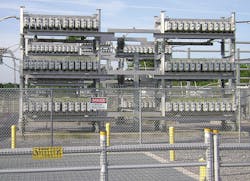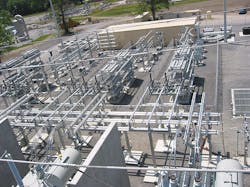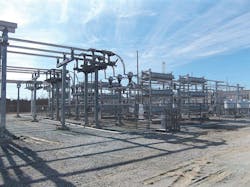Reactive Power Stabilizes the Grid
For anyone involved in the planning and management of America’s interconnected power system during the past 20 years, the term “rapidly changing” has become almost cliché. Many changes have accompanied the restructuring of the industry since the initial federal legislation in 1996. Some of these changes have impacted power supply, resulting in the proliferation of gas-fired generation, the shutdown of older fossil-fired generation and the encouragement of various renewable energy options. The end result of some of these changes has been a mismatch of supply and load, which has created challenges for power delivery and made voltage support an increasingly vital commodity. There also has been a rapid evolution of end-user technologies with changing load characteristics.
All of these developments have presented significant challenges to transmission operators concerning reactive power management and reserves. The recognition of these problems through the study of phenomena such as fault-induced delayed-voltage recovery has underlined the importance of maintaining adequate dynamic reactive power reserves to avoid voltage collapse. Higher transmission transfers over longer distances have resulted in the need for additional midline dynamic voltage support to achieve required transfer limits and defer the building of major transmission capacity.
The industry continues to wrestle with the challenges of siting transmission lines while also having to overcome the barriers presented by the laws of physics around the long-distance transmission of reactive power. As a result, the industry has seen a rapid increase over the past 10 years in the deployment of power-electronic-based dynamic reactive power sources, including static volt-ampere-reactive compensators (SVCs).
Need for Reactive Power
SVCs have been around for almost 40 years. Many of the older SVC systems are still in service, though some have undergone upgrades of their control and valve technologies. Despite the longevity of SVCs, many utilities are just now installing their first systems and concerned about the challenges of managing what is, for them, a new technology.
At Entergy Corp., various SVC technologies have been in place for almost 15 years. Over that period, the technology generally has performed well. The experience gathered presents the opportunity to share some of the lessons learned in managing these important assets.
Technical Specs
The technical specification for the SVC is perhaps the key ingredient to a successful and trouble-free experience throughout the life of the installation. The specification stage presents the best opportunity to design into the SVC a trouble-free ownership experience. A good starting point for the specification is IEEE standard 1031–2011 Guide for the Functional Specification of Transmission Static VAR Compensators. However, this guide needs to be augmented by additional input such as best practices and field experience. As with any standard, it should be applied with a firm grasp of the technical background of the stated requirements.
The development of the specification also presents the opportunity for another key strategy for success: the formation of a cross-functional team to guide the project through its various phases. The introduction of SVC technology at a utility will potentially impact several internal stakeholder groups including planning, operations, engineering, construction and field asset management. It is critically important to engage all of these groups in specification development and later phases of the project to foster ownership in and acceptance of the technology, as well as to ensure specific requirements for each group are adequately addressed at the specification stage.
By Design
The design of the SVC needs to be closely matched to the importance of the installation to system reliability. A design that does not adequately address the required level of availability will put undue pressure on the field asset management workforce when things go wrong and the system is down. In addition, an SVC that does not perform at the required level of availability will result in the SVC being marginalized by transmission operations planning and the investment will have been wasted.
For this reason, the specification needs to state clearly the required availability guarantee for the installation. This required availability will directly influence the level of redundancy provided for in the design. The required availability also must be coordinated closely with the stock of spare parts purchased with the system and maintained at required inventories during the availability guarantee, warranty periods and well into the life of the system. These requirements can be augmented by service contracts with the manufacturer of the SVC.
While the SVC must meet the availability requirements, it also must be dependable. When the SVC is called on to respond to a system event, it must do so correctly with a very high degree of confidence. If a systemic design flaw or setting error in the SVC installation results in both redundant systems failing to respond properly to such an event, this is clearly unacceptable, just as it would be for redundant relay protection systems. High dependability results from a conservative design philosophy, components of proven quality, comprehensive testing, and effective and fail-safe system monitoring.
A thorough design review process for all aspects of the project by the cross-functional team, robust control design verification and factory acceptance test program on a real-time simulator are key strategies to maximize the dependability of the SVC design.
The design review is the first project stage after contract award and gives all the groups represented on the cross-functional team the opportunity to discuss the details of the overall system design to ensure the requirements were understood and have been met. It represents the last opportunity to incorporate team input into the final design before committing to manufacture and construction.
Real-Time Simulation
The real-time simulator environment couples the real controls that will be installed in the field with a digital model of the SVC primary components and the power system at the location of the installation. This simulator environment provides the opportunity to explore thoroughly the behavior of the SVC, its controls and its protection systems throughout the specified operating envelope of system conditions (including harmonic resonances, low system damping, degraded network as a result of multiple contingencies, and many others). This kind of testing could never be performed on the real system.
The concept Entergy employs successfully is to use the real-time simulator testing as an opportunity to push the system to the edge of its operating capability and beyond to see where it fails. This approach provides the best opportunity to ensure the installation will respond as designed when called on to do so.
Training and Support
Finally, but by no means least important, are the matters of adequate training and ongoing support. Appropriate targeted training forms the foundation for understanding and accepting this new technology within the utility and enables the effective return on investment to be realized. Training is necessary for planning and engineering staff to understand how the technology functions and how it can be deployed effectively as a transmission investment. Training for control center dispatchers and operations planners helps them to understand the role of the technology in system reliability and voltage support, and how to operate the technology effectively so it performs as system planners intended.
Equally important, but perhaps most challenging, is the goal of ensuring ongoing competent technical support of the facility from field operations. These are the people who will own the system throughout its life. It is vital to their sense of ownership they not only understand the importance of the system but are familiar with the hardware, how to diagnose problems and how to perform routine maintenance. They also must develop a relationship with key support resources at the manufacturer.
Experience with a number of these projects points to the effectiveness of early engagement of field operations staff not only on the cross-functional project team but throughout testing, installation and commissioning particularly of the controls (including the human-machine interface, power electronic systems and cooling equipment). With the exception of the heavy currents and nonstandard voltages, the substation mechanics should be familiar with most of the outdoor equipment and, therefore, can be engaged as late as final commissioning tests. The control, communications and relay technicians will need to be engaged much earlier. The importance of this early engagement means the project budget should take their time into account.
Plan for the Costs
One final area deserves brief discussion: ongoing support costs. These systems are more complex than typical transmission elements found in substations like power transformers and conventional transmission line terminal equipment. Ongoing support costs include annual planned maintenance and upkeep, and the time and expense associated with diagnosing problems and replacing parts. While the conventional primary components will have the service life typical of this type of equipment in other installations, systems like power electronic valves, controls, cooling systems, and heating, ventilating and air conditioning (HVAC) equipment will have a shorter life span. Their depreciation life cycle should reflect this. Some of these costs can be covered in the early years of life by building service contracts with the manufacturer and extended warranties into the initial capital expenditure. However, multiyear support budget planning is an important activity to ensure the systems are supported adequately throughout their life.
Clay Adams ([email protected]) is the director of transmission project management and construction for Entergy. He is responsible for construction of transmission line and substation projects, including project assessment, definition, design, construction, closeout and evaluation. His group is also responsible for right-of-way acquisition, project controls and estimating support. Adams joined Entergy in 2000 as an engineer in transmission planning and has also served as transmission capital budget coordinator, project manager for reliability and infrastructure programs, supervisor of asset management and manager of substation design. He has represented Entergy on the Southeast Electric Exchange distribution overhead committee and in Southern Company benchmarking efforts. Adams holds a BSEE degree from Louisiana State University and is a certified project management professional.
Douglas J. Mader ([email protected]) retired from Entergy Corp. as director of IT infrastructure and enterprise services and is now an independent consultant in power systems. During his career at Entergy, he had responsibility for transmission business engineering, project management and construction functions. Prior to joining Entergy, Mader was with Nova Scotia Power Corp., where he rose to the position of vice president engineering of NS power services.



